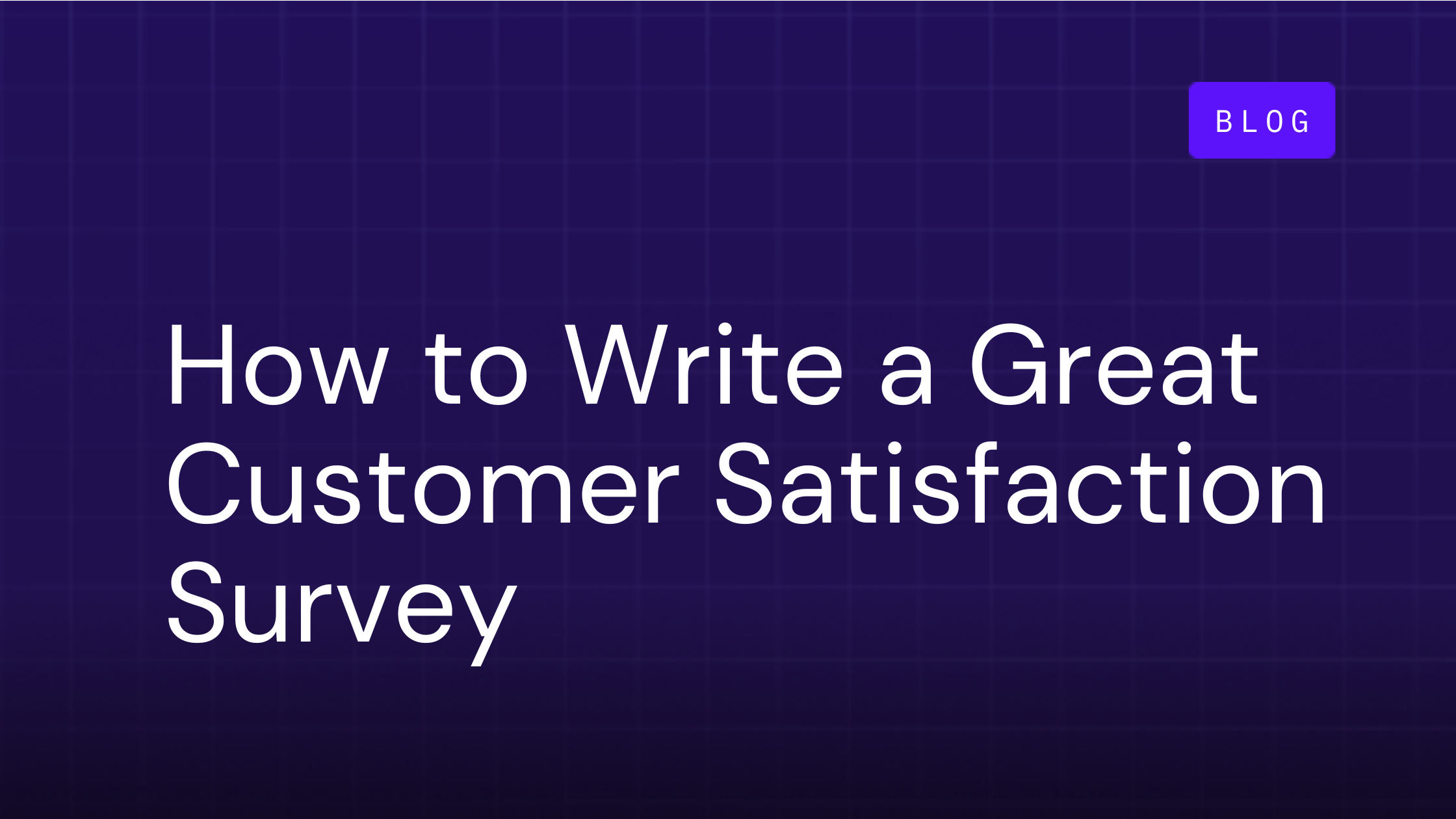How to Write a Great Customer Satisfaction Survey

Table of Contents
Customer satisfaction surveys are a game-changer if your business wants to improve its services and build loyal customer relationships. These surveys provide a window into your customers' minds, helping you understand their needs and improve your offerings. This article will explore why these surveys are so important, different methods you can use to measure satisfaction, and tips for creating effective surveys.
Why Measuring Customer Satisfaction is Crucial for Business Success
Measuring customer satisfaction isn't just about ticking a box. It's about creating a customer-centric culture where continuous improvement and excellence are the norms. Regularly gauging customer satisfaction can deepen relationships, boost loyalty, and drive long-term success.
It Helps You Build a Customer-Centric Culture
Incorporating customer satisfaction surveys into your business strategy signals that you value continuous improvement. This approach not only strengthens customer relationships but also drives long-term success.
"In business, the idea of measuring what you are doing, picking the measurements that count, like customer satisfaction and performance... you thrive on that."
— Bill Gates, Founder of Microsoft
It Encourages You To Be Better
Customer satisfaction surveys help identify areas needing enhancement. By regularly collecting and analyzing feedback, you're always striving for higher standards. In turn, this helps you retain customers and attract new ones.
"Unless you have 100% customer satisfaction, you must improve."
— Horst Schulze, Former President of Ritz Carlton
It Grows Your Business
Satisfied customers aren't just loyal—they're advocates. They spread positive word-of-mouth, recommend your services to others, and help build a strong reputation.
"A satisfied customer is one who will continue to buy from you, seldom shop around, refer other customers, and in general be a superstar advocate for your business."
— Gregory Ciotti, Content Marketing Specialist
Different Ways To Measure Customer Satisfaction
Understanding your customers' satisfaction helps you improve their experience. Here are several ways to measure their feelings about you and your products or services.
Customer Feedback Forms
- Purpose: Collect specific feedback right after key interactions.
- Why It Matters: Immediate feedback captures the customer's experience while it's still fresh, helping you quickly address any issues and improve your service on the spot.
- Implementation: Place feedback forms at the end of service interactions, on your website, or within mobile apps. Keep them short and straightforward to encourage completion.
- Pro Tip: Ask focused questions like "How was your experience today?" to get precise feedback that you can act on immediately.
Social Media Monitoring
- Purpose: Understand customer sentiment by analyzing social media mentions, comments, and reviews.
- Why It Matters: Social media gives you real-time, unfiltered feedback. By watching these platforms, you can gauge public perception and respond quickly to issues, turning potential negatives into positives.
- Implementation: Use social listening tools to track mentions and sentiments on platforms like X (formerly Twitter), Facebook, and Instagram.
- Pro Tip: Engage with both positive and negative mentions to show customers you're listening and care about their feedback.
Customer Reviews and Ratings on Third-Party Platforms
- Purpose: Gather public feedback from review sites like Google Reviews, Yelp, and industry-specific platforms.
- Why It Matters: Reviews influence potential customers and offer insights into how your business is perceived. Positive reviews attract new customers, while negative ones highlight areas for improvement.
- Implementation: Encourage customers to leave reviews after purchases and regularly monitor these platforms.
- Pro Tip: Respond to reviews promptly and constructively. Thank customers for positive feedback and address concerns raised in negative reviews to show your commitment to improvement.
Customer Support Interactions
- Purpose: Measure satisfaction through interactions with your support team.
- Why It Matters: The quality of support interactions can make or break customer satisfaction. Tracking these interactions helps you see where your support shines and where it needs work.
- Implementation: Monitor metrics like first call resolution, average response time, and follow-up surveys after support interactions.
- Pro Tip: Send follow-up surveys asking customers to rate their support experience and provide suggestions for improvement.
Behavioral Analytics
- Purpose: Analyze how customers interact with your website or product to gauge satisfaction.
- Why It Matters: Behavioral data reveals how customers use your products and services, showing you pain points and friction areas that might not come up in direct feedback.
- Implementation: Use tools like Google Analytics or heatmaps to track user interactions, time on site, and conversion rates.
- Pro Tip: Keep a close eye on this data to spot patterns that indicate satisfaction or frustration. For example, if your customers frequently abandon their carts, there may be an issue with the checkout process.
Churn Rate Analysis
- Purpose: Measure the rate at which customers stop using your products or services.
- Why It Matters: High churn rates can signal problems with your product or service that need addressing. Understanding why customers leave helps you make changes to improve retention.
- Implementation: Calculate the percentage of customers who leave over a specific period and analyze their reasons through exit surveys or follow-up calls.
- Pro Tip: Use churn analysis insights to create targeted retention strategies, like personalized follow-ups or improved onboarding processes.
Customer Satisfaction Surveys
- Purpose: Directly measure customer satisfaction with various aspects of your business.
- Why It Matters: Surveys give you detailed insights into customer preferences, experiences, and areas for improvement, helping you understand what drives satisfaction and loyalty. This tried-and-true method is one of the most impactful ways to measure customer satisfaction.
- Implementation: Design surveys with a mix of question types—Likert scale, multiple-choice, and open-ended questions—and distribute them via email, in-app prompts, or on your website.
- Pro Tip: Regularly update survey questions to reflect your current business goals and customer needs. That way, the data you collect is always relevant and actionable.
Why Use Customer Satisfaction Surveys
Customer satisfaction surveys may seem old-fashioned in a world full of new tools and techniques, but sometimes the simplest approach is the most effective. Directly asking your customers how they feel about your products or services—what they like and don't like—can provide invaluable insights.
Gain Valuable Insights
By asking customers about their experiences, preferences, and pain points, you better understand what they actually need. Surveys highlight where your business excels and pinpoint areas needing improvement, which helps you focus your efforts where they are most effective.
Improve Products and Services
Customer feedback provides concrete data to guide product development and service enhancements. This way, any changes you make align with customer desires and expectations. A study by PwC found that 73% of all people point to customer experience as an essential factor in their purchasing decisions.
Sometimes, customers suggest innovative ideas you might not have considered. Incorporating these suggestions can lead to new features or services that enhance your offering. Salesforce reported that 80% of customers expect companies to use their feedback to improve their experience.
Increase Customer Loyalty
Regularly seeking and acting on customer feedback demonstrates that you value their opinions, which can foster loyalty and increase customer retention. Research by Bain & Company shows that increasing customer retention rates by 5% increases profits by 25% to 95%.
Transparently addressing issues and communicating improvements based on customer input builds trust and reinforces your commitment to customer satisfaction. According to Edelman, 71% of consumers say trust in a brand is more important to them today than it used to be.
Enhance Customer Experience
Understanding specific customer preferences allows you to tailor their experiences, making interactions more personal and satisfying. Given today's technology, 73% of customers expect better personalization.
You can reduce customer churn and improve overall customer satisfaction scores by addressing dissatisfaction promptly. After all, acquiring a new customer is more expensive than retaining an existing one.
Drive Business Growth
Customer satisfaction surveys provide critical data that can inform strategic business decisions, from marketing strategies to operational changes. Forrester reported that companies that use data-driven marketing are 8.5 times more likely to be profitable year-over-year.
Satisfied customers are more likely to make repeat purchases and recommend your business to others, driving sales and growth through positive word-of-mouth.
Benchmark Performance
Surveys help you establish benchmarks for customer satisfaction so you can measure performance over time and against industry standards. The American Customer Satisfaction Index helps companies compare customer satisfaction scores with industry benchmarks.
Regular surveys enable you to track improvements and monitor the effectiveness of changes implemented, ensuring continuous progress toward higher customer satisfaction.
3 Types of Customer Satisfaction Surveys
When it comes to measuring customer satisfaction, there are a few tried-and-true methods that businesses rely on. Each type of survey offers unique insights into different aspects of the customer experience.
CSAT (Customer Satisfaction Score)
- What It Measures: CSAT gauges overall satisfaction with a product or service on a scale, typically from 1 to 5.
- Why It Matters: This quick and straightforward survey helps you understand how happy your customers are with specific aspects of your service or product. It's great for getting a snapshot of customer sentiment after key interactions or purchases.
- Example Question: "How satisfied are you with our service on a scale of 1 to 5?"
- Pro Tip: To gather more detailed feedback, follow up with an open-ended question like, "What could we do to improve your experience?"
NPS (Net Promoter Score)
- What It Measures: NPS assesses customer loyalty by asking how likely customers are to recommend your company to others.
- Why It Matters: NPS is a powerful indicator of customer loyalty and can predict business growth. Customers willing to recommend your business are valuable promoters, while those who aren't can provide insights into areas needing improvement.
- Example Question: "How likely are you to recommend our service to a friend or colleague?"
- Pro Tip: Segment NPS responses into Promoters (9-10), Passives (7-8), and Detractors (0-6) to better understand different customer groups and tailor your strategies accordingly.
CES (Customer Effort Score)
- What It Measures: CES evaluates how easily customers can complete an interaction or resolve an issue.
- Why It Matters: This survey focuses on the effort required from the customer's perspective. Reducing customer effort is necessary for improving overall satisfaction and loyalty, as customers prefer seamless and hassle-free experiences.
- Example Question: "How easy was it to resolve your issue with our service?"
- Pro Tip: Use CES to identify and eliminate pain points in your customer journey, making interactions smoother and more efficient.
5 Steps To Create an Effective Customer Satisfaction Survey
Creating an effective customer satisfaction survey isn't just about asking a few questions and hoping for insightful answers. It requires careful planning and thoughtful design.
1. Define Your Objectives
- Identify Specific Goals: Know what you want to achieve before you start. Are you looking to improve customer service, gather product feedback, or something else? Clear objectives will guide your entire survey process.
- Align Questions with Business Objectives: Make sure each question serves your overall goals. If your aim is to enhance customer service, your questions should focus on service-related experiences and outcomes.
- Actionable Tip: Write down your primary goals and refer back to them as you craft each question to ensure alignment.
2. Choose the Right Survey Type
- Determine the Appropriate Survey Type: Based on your objectives, choose between CSAT, NPS, CES, or a combination. Each type provides different insights.
- Consider Timing and Frequency: Decide when and how often to send surveys. Post-purchase surveys capture immediate reactions, while quarterly surveys can track ongoing satisfaction trends.
- Actionable Tip: If you need help deciding which type to choose, pilot a small sample of each to see which yields the most useful data.
3. Craft Clear and Relevant Questions
- Consider These Question Types:
- Likert Scale Questions: Measure degrees of satisfaction. Example: "How satisfied are you with our service?"
- Binary Questions: Simple yes/no responses. Example: "Were you satisfied with your experience?"
- Multiple Choice Questions: Provide specific options for detailed insights. Example: "Which of our services was most useful today?"
- Open-Ended Questions: Allow detailed feedback in customers' own words. Example: "What could we have improved?"
- Best Practices for Question Wording: Avoid jargon, be concise and clear. The goal is to make it easy for customers to understand and answer questions accurately.
- Actionable Tip: Test your questions on a small group of employees or colleagues first to catch any confusing wording.
4. Optimize Survey Design
The structure and content of your CSAT survey significantly influence the quality of the feedback received. Holder's recommendations for creating effective surveys include:
- Use a 1-7 Scale: Traditional 1-10 scales can lead to skewed results due to their familiarity and ease of use. A 1-7 scale encourages respondents to think more thoroughly about their answers, resulting in more accurate and insightful feedback.
- Limit to 5 Questions: Long surveys can lead to respondent fatigue and drop-off, reducing the quality and quantity of the feedback. Keep your surveys concise, focusing on the most critical questions to ensure higher completion rates.
- Send from a Generic Company Email: Surveys sent from a generic company email (e.g., surveys@yourcompany.com) are less likely to be biased by personal relationships or perceptions of individual team members. This helps in collecting unbiased and honest feedback.
- Ask About Product/Service Performance Relative to Expectations: One of the most insightful questions you can ask is how well your product or service is performing compared to the customer's expectations. This question can reveal gaps between what customers anticipated and what they actually experienced, providing valuable direction for improvements.
5. Test and Iterate
- Pilot the Survey: Test it with a small group to identify any issues. This step is crucial for catching problems before the survey goes live.
- Analyze Pilot Responses: Use the feedback to refine your questions and format. Adjust any unclear or irrelevant questions.
- Implement A/B Testing: Try different question formats or wordings to see which versions get the best responses. This can help you continuously improve your surveys.
- Actionable Tip: Regularly review and update your survey based on feedback and changing business objectives. Continuous improvement ensures your surveys remain effective and relevant.
Implementing the Survey
Getting your customers to take your survey is just as important as designing it. Here's how to get your survey in front of your audience.
Distribution Methods
Test multiple distribution methods to see which ones yield the highest response rates and best quality feedback.
Email Surveys
- Pros: Convenient for customers, easy to track and analyze.
- Cons: Can be ignored or marked as spam.
- Tips for Maximizing Response Rates: Personalize the email, keep the subject line engaging, and send follow-up reminders.
In-App Surveys
- Pros: Immediate feedback from users while they engage with your product.
- Cons: Can interrupt the user experience if not well-timed.
- Tips for Maximizing Response Rates: Trigger surveys after significant actions (e.g., completing a purchase) and keep them short and relevant.
Website Pop-Ups
- Pros: High visibility, immediate response.
- Cons: Can be intrusive and annoying.
- Tips for Maximizing Response Rates: Use exit-intent pop-ups to avoid disrupting the user experience and limit the frequency of pop-ups.
Social Media Platforms
- Pros: Broad reach, engages users in their preferred environment.
- Cons: Can be less targeted and harder to track.
- Tips for Maximizing Response Rates: Use engaging visuals and promote surveys with incentives like discounts or entry into a giveaway.
Timing and Frequency
Timing is crucial when deploying CSAT surveys. To gather the most relevant and actionable feedback, it's essential to send these surveys at key moments in the customer journey:
- Post-Onboarding Completion: After a customer completes the onboarding process, they have had the chance to interact with your product or service and form an initial impression. This is an opportune time to ask for feedback on their onboarding experience, helping you identify any areas that may need improvement.
- When a Customer Shows Signs of Churning: If a customer appears to be disengaging or slipping away, a CSAT survey can help understand the reasons behind their waning interest. This proactive approach can provide insights into potential issues and allow you to address them before the customer decides to leave.
- 2-3 Months Prior to Renewal: Sending a CSAT survey a few months before a contract renewal gives you time to address any concerns and reinforce the value your product or service provides. This can help improve renewal rates and foster long-term customer relationships.
- When There’s a Change in Stakeholders: Changes in key stakeholders within your customer's organization can impact their perception and experience with your product or service. Sending a survey in such instances helps ensure that the new stakeholders' needs and expectations are understood and met.
Interpreting and Implementing CSAT Results
Gathering feedback is only the first step; interpreting and acting on that feedback is where the true value lies. Holder suggests the following best practices for making the most of your CSAT survey results:
- Tie Results to Company Objectives or OKRs: Linking CSAT results to specific company objectives or OKRs (Objectives and Key Results) ensures that the feedback translates into actionable items. This alignment increases the likelihood that necessary changes will be implemented.
- Segment Results by Key Criteria: Analyzing survey results based on different segments such as company size, customer persona, and stage in the customer journey provides deeper insights. This segmentation allows you to tailor your strategies and improvements to specific customer groups, enhancing overall satisfaction.
- Follow Up with Respondents: Sending a follow-up note to respondents shows that their feedback is valued and considered. Addressing the concerns of less satisfied customers directly and creating a plan to improve their experience can foster loyalty and engagement.
Taking Action on Feedback
Once you've analyzed the data, it's time to act on it:
- Focus on Critical Areas: Identify the most frequent and impactful issues from the survey results. Develop action plans to address these areas and improve customer satisfaction.
- Create a Feedback Loop: Show customers you value their feedback by informing them of the changes made based on their input. Regularly update customers on progress and improvements to maintain engagement and trust.
Communicate Changes to Customers
- Inform Customers: Communicate the changes made based on their feedback through newsletters, blog posts, or direct emails. Highlight specific improvements and how they address customer concerns.
- Build Trust and Loyalty: Transparently addressing issues and showing that you act on feedback builds trust and reinforces your commitment to customer satisfaction. Share success stories and positive changes driven by survey feedback to create a positive narrative around customer engagement.
- Actionable Tip: Use storytelling to make your communications about changes more engaging and relatable for your customers.
Best Practices for Continuous Improvement
To keep things fresh:
- Regularly update your survey questions to reflect what's happening in your business and with your customers.
- Make sure the questions stay relevant and focused on your current goals.
- Keep that feedback loop going strong by continuously collecting and acting on customer feedback.
- Share updates showing how their input has made a difference.
Use this feedback to guide your overall business strategy, from product tweaks to marketing moves. Make customer insights a crucial part of your planning. Hold regular team sessions to review survey results and map out your next steps for ongoing improvement. This way, you'll always stay in tune with your customers — and ahead of the curve.
Additional Tips for CSAT Success
Beyond the core best practices, there are additional strategies to consider for maximizing the effectiveness of your CSAT surveys:
- Incorporate Open-Ended Questions: While keeping the survey short is crucial, including at least one open-ended question can provide rich, qualitative insights. This allows customers to express their thoughts in their own words, revealing underlying issues or suggestions that might not be captured in closed-ended questions.
- Automate Survey Distribution: Use automation tools to schedule and send surveys at the optimal times identified in the customer journey. Automation ensures consistency and frees up your team to focus on analyzing results and implementing improvements.
- Regularly Review and Update Surveys: Customer needs and expectations evolve over time, so it's important to regularly review and update your CSAT surveys. This ensures that your questions remain relevant and continue to provide valuable insights.
- Benchmark Against Industry Standards: Comparing your CSAT results with industry benchmarks can provide context for your performance. It helps identify areas where you excel and where you need to improve relative to your competitors.
- Share Results Internally: Communicating survey results across your organization ensures that everyone understands the customer perspective. This shared understanding can drive a customer-centric culture and encourage collaboration towards common goals.
- Celebrate Successes: Recognize and celebrate positive feedback and high satisfaction scores. This boosts team morale and reinforces the behaviors and practices that contribute to customer satisfaction.
Conclusion
Customer satisfaction surveys are a powerful tool for understanding your customers and improving their experience with your product or service. By following Paul Holder's best practices for timing, crafting, and interpreting CSAT surveys, you can gather more accurate and actionable feedback. Remember to tie results to company objectives, segment by key criteria, and follow up with respondents to show that their feedback is valued.
By implementing these strategies, your organization can enhance customer satisfaction, reduce churn, and drive long-term success.
Paul Holder is cofounder and CEO of OnRamp, a B2B customer onboarding solution improving customer engagement and operational efficiency. Prior to OnRamp, I led Customers Success at Troops (acq. Salesforce), a SaaS startup changing the way humans interact with their CRMs, and customer onboarding at VTS, which is transforming the commercial real estate industry.
Related Posts:

How To Adapt Onboarding Strategies To Meet Customers’ Learning Style
Originally shared on Forbes Business Council

Security: What to Look for in Customer Onboarding Software Evaluation
Choosing customer onboarding software isn’t just about features and usability - it’s about trust.

How to Scale White-Glove Onboarding and Do More With Less
Sounds great, right?